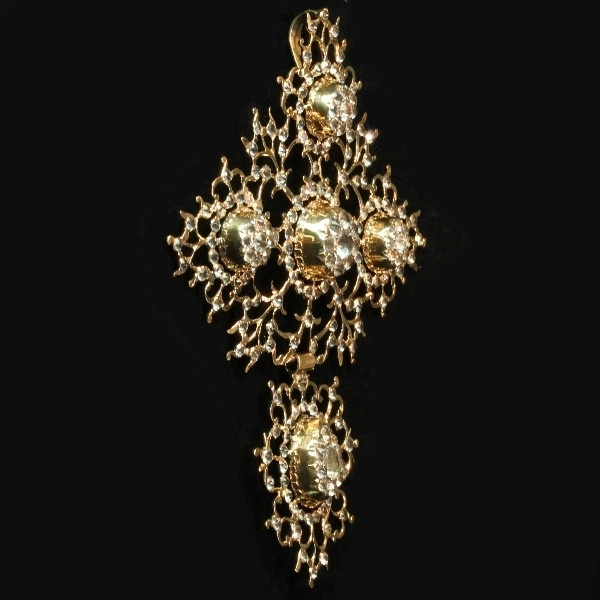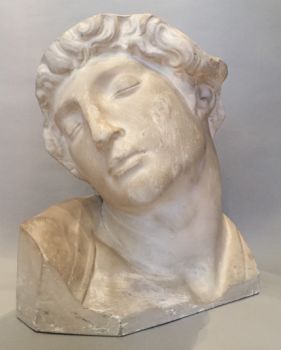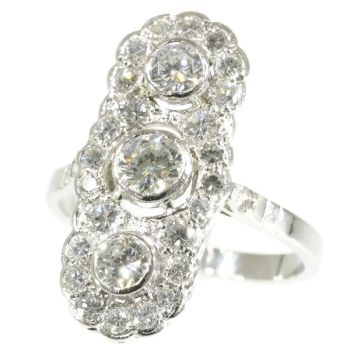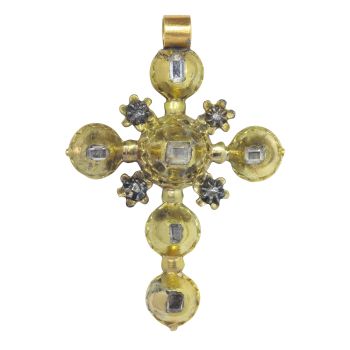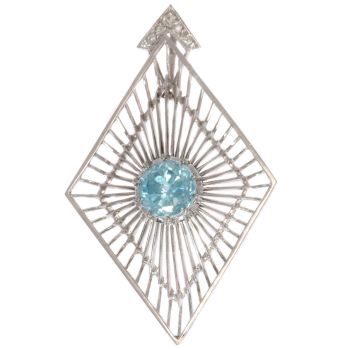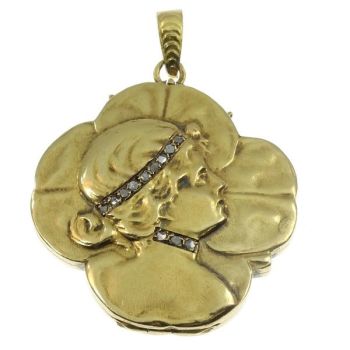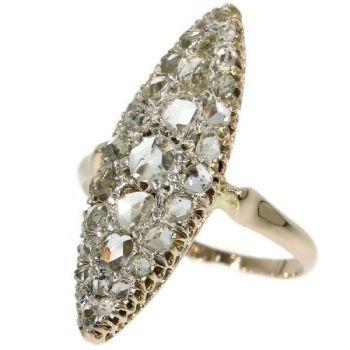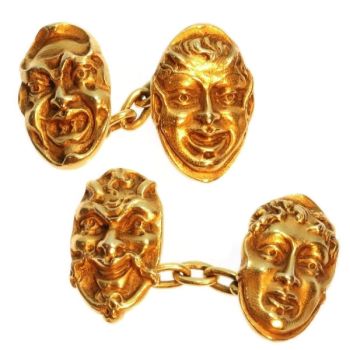French antique gold Normandic cross Georgian period 1809
Unknown artist
Adin Fine Antique Jewellery
- About the artwork
This 18K red gold French Provincial cross pendant from the Normandic region is a rare Georgian jewel from 1809. On each corner and in the centre of this openwork scrollwork lozenge-shaped cross, a cluster of strass stones transcends from an emanatingaureole of strass stones. A pear-shaped haloed cluster surmount completes this palette of curling branches enriched with even more strass stones as dew drops glistening from this fashion statement of the devout women of every era.
Antique jewelry object group: pendant
This is a traditional Normandic regional jewellery piece, and just as traditional costumes denote the social and geographicaldifferences between regions based on colour and cut, so do these regional jewellery pieces. This specific design is a Croix deSaint-Lô or Quadrille. According to specialists at the V&A these were sometimes made of gold in the 18th century, but by the mid-19th century they were only made of silver.
Condition: excellent condition
- (more info on our condition scale)
Country of origin: France
Style: Georgian - Georgian style is the name given in most English-speaking countries to the set of styles current between 1720 and 1840. It is eponymous for the first four British monarchs of the House of Hanover—George I of Great Britain, George II of GreatBritain, George III of the United Kingdom, and George IV of the United Kingdom—who reigned in continuous succession from August 1714 to June 1830.
- See also: Georgianor more info on styles
Period: ca. 1809
- (events and facts in 1809)
Source of inspiration: Christianity
Theme: Cross - The cross is one of the most ancient human symbols, and is used by many religions, such as Christianity. It is frequently a representation of the division of the world into four elements (or cardinal points), or alternately as the union of theconcepts of divinity, the vertical line, and the world, the horizontal line. (from: Wikipedia)
Material: 18K red gold
- (more info on precious metals)
Extra information: Provincial French cross - This cross belongs to the rare group of French Provincial gold cross pendants that were made at the end of the 18th Century and the beginning of the 19th Century (ca. 1790-1820).Most probably, the cross comes from the Normandic region.
In our days, regional crosses are very scarce compared to the variety that existed in the old days. There are more than 10 models known for Savoie andProvence, but also in Alsace, Bretagne and northern of France. Examples of most of these crosses are now kept in museums in Arles and Paris.
No other emblem of the 18th century was more iconic than the cross. It managed to be, at the sametime, both a symbol of faith and a fashion statement. It flashed in diamonds upon the décolletés of wealthy peoplein cities all over France, but its daily presence glowing at the throats of devout women of the regional provincies was at leastas powerful. Shining equally brilliantly in churches, and ballrooms, the emblematic force of the cross as a spiritual symbol and a beautiful adornment has never ceased to mesmerise.
A much used quote (in 1752) from the smartly dressed Lady JaneCoke was: "You can't make a mistake as to the length of your cross. You may either wear it high upon your neck or let the bottom of it touch the top of your stays".
Strass - A brilliant paste made out of lead glass and used to simulate various transparant gemstones. It is a borosilicate of potassium and lead, with small quantities of alumina. When uncoloured it was used to simulate diamonds, beingtransparent and very refractive, although much softer; the addition of metallic oxides and salts produces coloured strass to imitate most known gemstones. It is named after Georges-Frédéric Strass (1701-1773) who was born at Wolfsheim,near Strasbourg, where he learned to make jewelry and artificial gems; he moved to Paris in 1724, and there invented, from 1730to 1734, new techniques for making imitation precious stones (imitation diamonds having been known in Paris in the 17th century).He ceded the making of such ware in 1752 to Georges-Michel Bapst (1718-1780), husband of his niece. Such artificial gems are nowmade mainly in Czechoslovakia, Austria, and France. Many writers and standard dictionaries have attributed the invention to aJoseph Stras(s)(er) of Vienna, but no record of such a person is known, and the legends about him has been discredited.
Precious stones:Many white strass stones (also called paste) as diamond imitation.
- (more info on precious stones)
Birthstones: Diamond is the birthstone (or month stone) for April.
- (more info on birthstones)
Hallmarks: The French hallmark depicting a rooster's head which was used in France for 18K gold around 1810.
- (more info on hallmarks)
Dimensions: height 8,60 cm (3,39 inch), width 7,96 cm (3,13 inch)
Weight: 19,20 gram (12,35 dwt)
Reference Nº: 14161-0016
Copyright photography: Adin, fine antique jewelry
- About the artist
It might happen that an artist or maker is unknown.
Some works are not to be determined by whom it is made or it is made by (a group of) craftsmen. Examples are statues from the Ancient Time, furniture, mirroirs, or signatures that are not clear or readible but as well some works are not signed at all.
As well you can find the following description:
•“Attributed to ….” In their opinion probably a work by the artist, at least in part
•“Studio of ….” or “Workshop of” In their opinion a work executed in the studio or workshop of the artist, possibly under his supervision
•“Circle of ….” In their opinion a work of the period of the artist showing his influence, closely associated with the artist but not necessarily his pupil
•“Style of ….” or “Follower of ….” In their opinion a work executed in the artist’s style but not necessarily by a pupil; may be contemporary or nearly contemporary
•“Manner of ….” In their opinion a work in the style of the artist but of a later date
•“After ….” In their opinion a copy (of any date) of a work of the artist
•“Signed…”, “Dated….” or “Inscribed” In their opinion the work has been signed/dated/inscribed by the artist. The addition of a question mark indicates an element of doubt
•"With signature ….”, “With date ….”, “With inscription….” or “Bears signature/date/inscription” in their opinion the signature/ date/ inscription has been added by someone other than the artist
Are you interested in buying this artwork?
Artwork details
Related artworks
- 1 - 4 / 12
- 1 - 4 / 24
- 1 - 4 / 24
- 1 - 4 / 24
- 1 - 4 / 24
- 1 - 4 / 12




